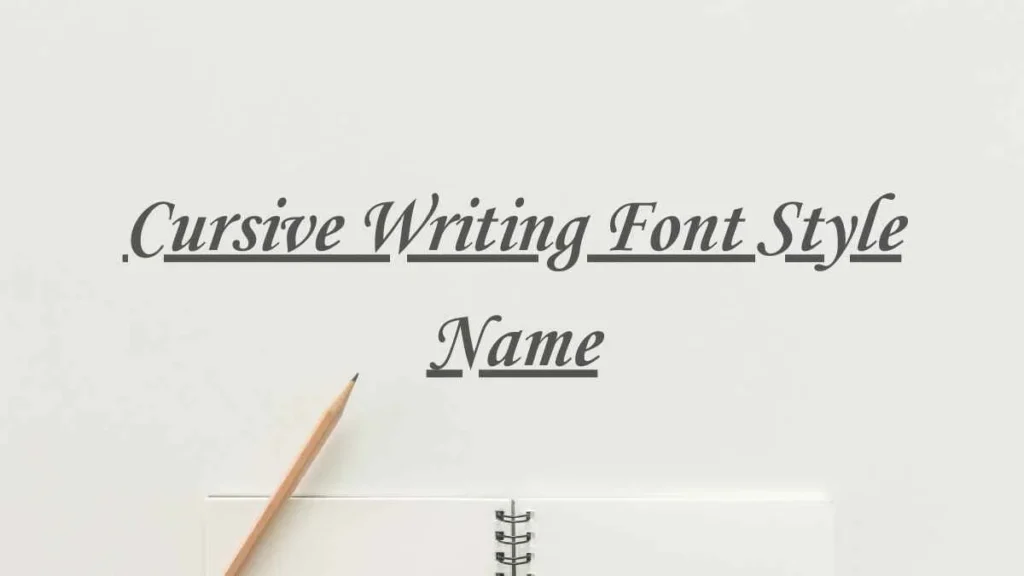Cursive writing, with its flowing and connected letters, has long been a favorite among designers, calligraphers, and educators. Whether you’re looking to add a touch of elegance to a wedding invitation or teach a child the art of beautiful handwriting, choosing the right cursive writing font style name is essential. In this comprehensive guide, we’ll explore various cursive font styles, discuss their origins, and offer tips on how to use them effectively.
What is Cursive Writing?
Cursive writing is a style of penmanship in which the letters are connected in a flowing manner, often to make writing faster. Historically, cursive writing was used in formal documents and personal correspondence, but it has become a popular typographic choice in digital design.
The Importance of Choosing the Right Cursive Writing Font Style Name
Selecting the right cursive font can set the tone for your project, convey a certain mood, and even impact readability. Different cursive writing font styles carry different connotations. So it’s important to choose one that aligns with your intended message.

Popular Cursive Writing Font Style Names
Here’s a list of popular cursive writing font styles, along with a brief description of each:
- Lobster: A bold and curvy font, Lobster is great for headlines and titles. It combines the beauty of cursive writing with a modern twist, making it perfect for various design projects.
- Brush Script: This is a classic cursive font that mimics the strokes of a brush. It’s often used in logos and branding to convey a sense of friendliness and approachability.
- Pacifico: Known for its playful and casual appearance, Pacifico is a cursive font that’s perfect for informal projects like party invitations or social media graphics.
- Great Vibes: An elegant and sophisticated cursive font, Great Vibes is often used in wedding invitations and formal event signage.
- Dancing Script: True to its name, it has a lively and whimsical feel. This font is perfect for projects that require a touch of fun and creativity.
- Allura: This font is both graceful and readable, making it ideal for longer text passages in invitations or greeting cards.
Historical Influences on Cursive Font Styles
Cursive writing has a rich history, influenced by various cultural and historical factors. The development of different cursive font styles can be traced back to ancient scripts and the calligraphy of different civilizations:
- Spencerian Script: Developed in the mid-19th century, this style of cursive writing was widely used in the United States, particularly in business correspondence. It’s known for its elegant and elaborate loops.
- Copperplate Script: Originating in the 16th century, Copperplate Script is a delicate and formal cursive style. It was traditionally used for official documents and is now often used in formal invitations and certificates.
- Italic Hand: A simpler and more legible cursive style that originated in Renaissance Italy, the Italic Hand was designed for speed and efficiency. It remains popular in modern handwriting.
How to Choose the Right Cursive Writing Font Style
When selecting a cursive writing font style name for your project, consider the following factors:
- Purpose: What is the main purpose of your design? Formal invitations may call for a more traditional cursive style. While a casual event might be better suited to a playful font.
- Readability: Some cursive fonts can be difficult to read at smaller sizes. If your text needs to be easily legible, opt for a simpler cursive font with less embellishment.
- Tone: The tone of your message should match the style of your font. An elegant cursive font might convey sophistication. While a bold, quirky font could add a sense of fun.
- Consistency: Ensure that your font choice is consistent with the overall theme of your design. Mixing too many different styles can make your project look disjointed.

Using Cursive Fonts in Modern Design
Cursive fonts are incredibly versatile and can be used in a variety of design projects:
- Wedding Invitations: Elegant cursive fonts like Great Vibes or Copperplate Script can add a timeless, romantic touch to your invitations.
- Branding: Fonts like Lobster or Brush Script can give your brand a distinctive, memorable look.
- Social Media Graphics: Use playful cursive fonts like Pacifico or Dancing Script to make your social media posts stand out.
- Educational Materials: Simple cursive fonts are often used in educational materials to help children learn cursive handwriting.
Conclusion
Cursive writing font style names are more than just a way to categorize fonts. They’re a critical element in design that can influence the overall impact of your project. Whether you’re aiming for elegance, fun, or something in between, understanding the different cursive font styles and their appropriate uses will help you make informed decisions.
When choosing a cursive writing font style name, always consider the purpose, readability, and tone of your project. With so many beautiful options available, you’re sure to find the perfect cursive font to enhance your next design.


2 thoughts on “Cursive Writing Font Style Name: A Guide to Elegant Script Fonts”